Mike Norman’s show
Wednesday, September 17, 2008 @ 11:06 EST
Houston Area: Houston 1110 AM KTEK
Dallas / Fort Worth Area: DFW 1110 AM KJSA
[top]

Wednesday, September 17, 2008 @ 11:06 EST
Houston Area: Houston 1110 AM KTEK
Dallas / Fort Worth Area: DFW 1110 AM KJSA
[top]
Wonder if Fisher cut a deal not to dissent for the hawkish inflation language?
Karim writes:
Decision (no cut) may be hawkish relative to expectations, but wording mostly dovish.
1st paragraph-all changes highlight downside risks to gwth; slowing export gwth a new wrinkle in addition to the usual financial market strains, labor market weakness and housing.
2nd paragraph-identical to prior except mention of inflation expectations has been dropped; so a downgrading of concern over inflation.
3rd paragraph-‘stand ready to act’ but no mention of ‘in a timely manner’.
Fisher dropped his dissent
Strains in financial markets have increased significantly and labor markets have weakened further. Economic growth appears to have slowed recently, partly reflecting a softening of household spending. Tight credit conditions, the ongoing housing contraction, and some slowing in export growth are likely to weigh on economic growth over the next few quarters. Over time, the substantial easing of monetary policy, combined with ongoing measures to foster market liquidity, should help to promote moderate economic growth.
Inflation has been high, spurred by the earlier increases in the prices of energy and some other commodities. The Committee expects inflation to moderate later this year and next year, but the inflation outlook remains highly uncertain.
The downside risks to growth and the upside risks to inflation are both of significant concern to the Committee. The Committee will monitor economic and financial developments carefully and will act as needed to promote sustainable economic growth and price stability.
Economic activity expanded in the second quarter, partly reflecting growth in consumer spending and exports. However, labor markets have softened further and financial markets remain under considerable stress. Tight credit conditions, the ongoing housing contraction, and elevated energy prices are likely to weigh on economic growth over the next few quarters. Over time, the substantial easing of monetary policy, combined with ongoing measures to foster market liquidity, should help to promote moderate economic growth.
Inflation has been high, spurred by the earlier increases in the prices of energy and some other commodities, and some indicators of inflation expectations have been elevated. The Committee expects inflation to moderate later this year and next year, but the inflation outlook remains highly uncertain.
Although downside risks to growth remain, the upside risks to inflation are also of significant concern to the Committee. The Committee will continue to monitor economic and financial developments and will act as needed to promote sustainable economic growth and price stability.
[top]
(an email exchange)
>
> On Tue, Sep 16, 2008 at 10:24 AM, Tom wrote:
>
> Hi Coach,
>
> While financial markets are in a meltdown not unlike the post 9/11
> experience,
>
yes, major deleveraging going on
>
> the good news is that central banks around the world are providing
> coordinated liquidity injections along with other positive actions that may
> create a new basis for global financial rescues.
>
yes, but all that does is set the fed funds rate and term fed funds rate. it’s about price, not quantity
>
> The creation of the League of Nations was an example of how the world
> responded to WWI.
>
> Tom
>
> P.S. But it is still not time to buy stock.
>
agreed!
watch for fiscal policy to do the heavy lifting to support GDP and employment.
[top]
Highlights:
| Aug Consumer Sentiment Hits Record Low For 3rd Month |
| Govt Panel To Call For Cutting Corporate Tax To 30% By FY15 |
| Ota Reelected As New Komeito Leader For Another 2 Years |
| Extra Budget To Total 1.81tn Yen, Govt Eyes 400bn Yen Bonds |
| Lehman Failure Not To Mar Japan Financial System: Ibuki |
| BOJ Injects Y1.5tln To Calm Markets |
| New-Condo Offerings Tumble 38% In Tokyo, Rise 7% In Osaka For Aug |
| Forex Focus: Yen To Benefit From Banking Woes |
| Stocks: Slide To 3-Year Low As Banks, Insurers Tumble |
| Bonds: Surge After Lehman Bankruptcy, Market Turmoil |
Note Japan’s proposed fiscal responses: cutting corp tax and extra budget, while the proposed increased consumption tax has been delayed.
Same in most nations around the world.
Fiscal responses ‘work’ while interest rate cuts don’t.
The US tax rebates worked while there is no econometric evidence the rate cuts did anything, except maybe make things worse as they reduced personal income and contributed psychologically to a USD sell off and spike in import prices that probably hurt consumers at least as much as it helped exporters.
The Fed could to anything today from unchanged to a 50 cut.
They seemed to have decided to use interest rates for ‘monetary policy’ and other tools for ‘market functioning’.
So for market functioning they just expanded the scope of the TAF and the Treasury lending facility, and may do more of that type of thing at today’s meeting, including adjusting the terms of the discount rate.
The question is whether falling commodities and the stronger USD will lead to a further rate cut.
What the Fed knows and has recognized since the Bear Stearns episode is that markets are going to open every day and do their thing, as the last week’s activity has demonstrated.
The Fed’s perceived risk of markets simply not opening and not trading has subsided.
Also, with the Treasury take over of the agencies mtg rates have dropped over 50 bp and availability of mortgage funding has been sustained.
The Fed considers this an ‘easing of financial conditions’ and is the move they’ve wanted to see to support housing, which has shown signs of stabilizing.
And the Treasury has shown it’s there to ‘write the check’ as it sees the need to prevent systemic risk.
So from that point of view there has already been a substantial ease in ‘financial conditions’, and the Fed may not see a need for further immediate ease.
Their forecasts will continue to show ‘moderating inflation and continued downside risks to growth’.
It all depends on their fear factor. They could leave fed funds unchanged or cut up to 50, depending on their concern regarding systemic risk.
[top]
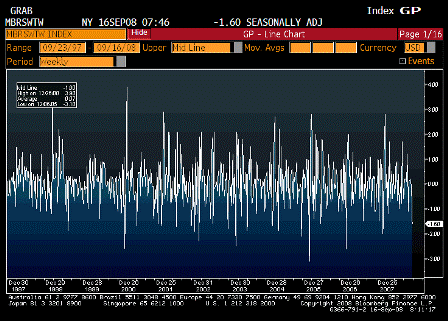
| Survey | n/a |
| Actual | -1.6 |
| Prior | -0.1 |
| Revised | n/a |
Not a good sign, but partially seasonal (see year over year below). Shoppers getting scared by the financial sector again?
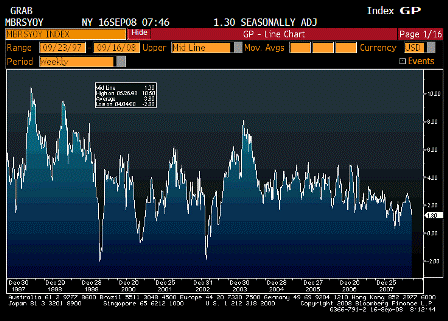
| Survey | n/a |
| Actual | 1.30 |
| Prior | 1.90 |
| Revised | n/a |
Down a bit, but still positive.
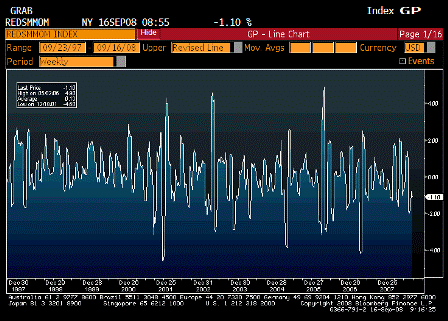
| Survey | n/a |
| Actual | -1.10 |
| Prior | -0.8 |
| Revised | n/a |
Same, down some but somewhat seasonal (see year over year).
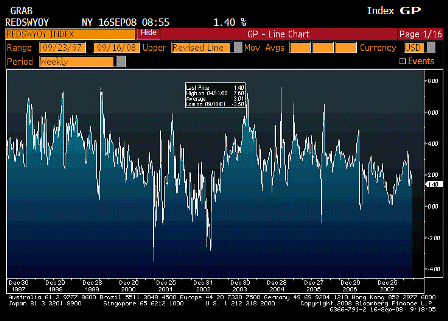
| Survey | n/a |
| Actual | 1.40 |
| Prior | 1.80 |
| Revised | n/a |
Down some but still positive and off the bottom.
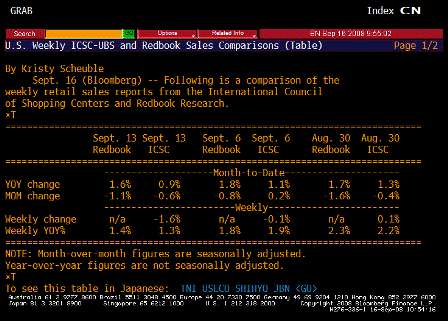
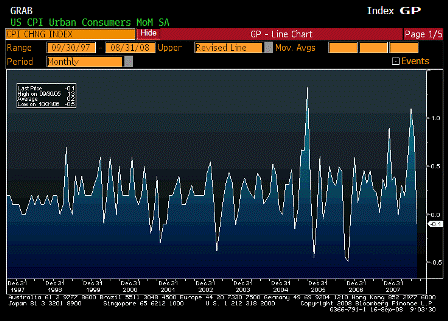
| Survey | -0.1% |
| Actual | -0.1% |
| Prior | 0.8% |
| Revised | n/a |
Down only a tenth even with the big drop in commodities.
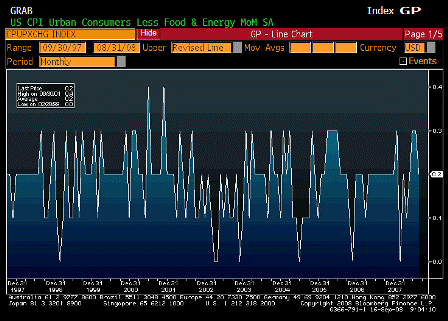
| Survey | 0.2% |
| Actual | 0.2% |
| Prior | 0.3% |
| Revised | n/a |
No let up here but this lags headline.
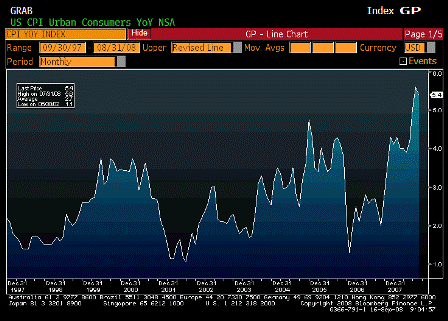
| Survey | 5.5% |
| Actual | 5.4% |
| Prior | 5.6% |
| Revised | n/a |
Not much of a drop here as crude fell last august as well.
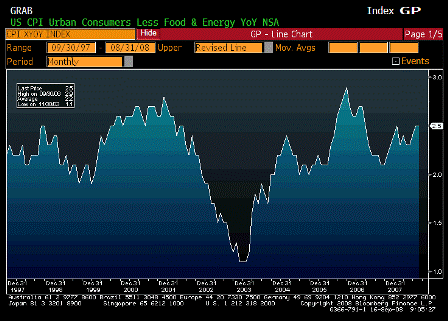
| Survey | 2.6% |
| Actual | 2.5% |
| Prior | 2.5% |
| Revised | n/a |
Way above the Fed’s target and comfort zone
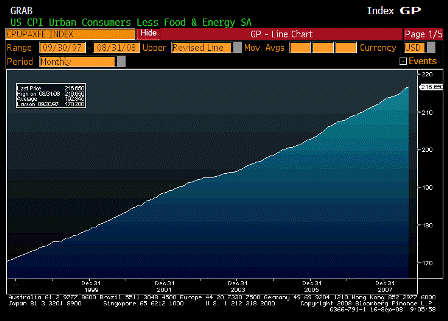
| Survey | n/a |
| Actual | 216.650 |
| Prior | 216.230 |
| Revised | n/a |

| Survey | 219.300 |
| Actual | 219.086 |
| Prior | 219.964 |
| Revised | n/a |
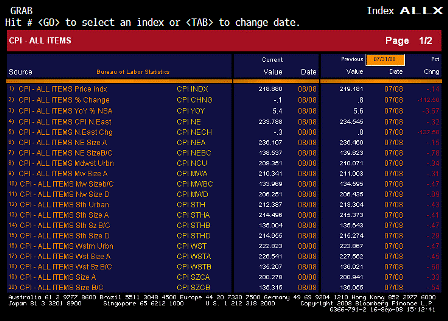
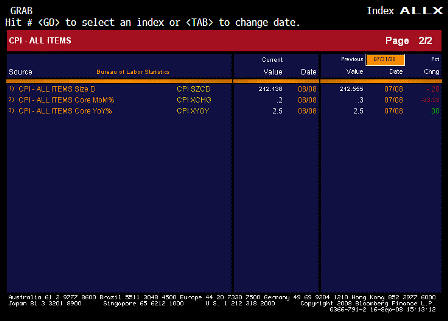
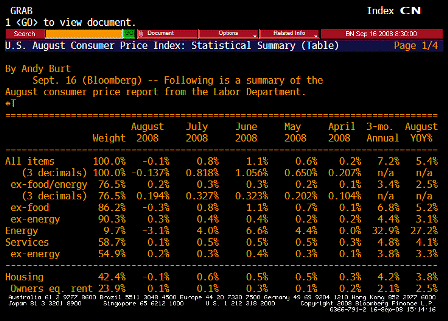
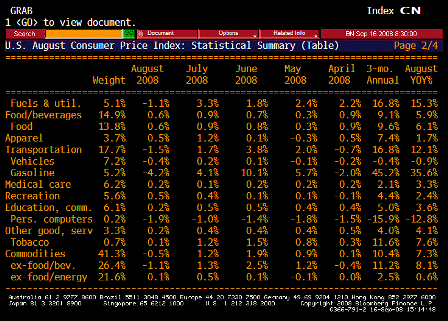
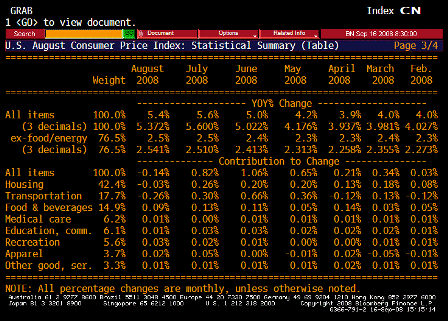
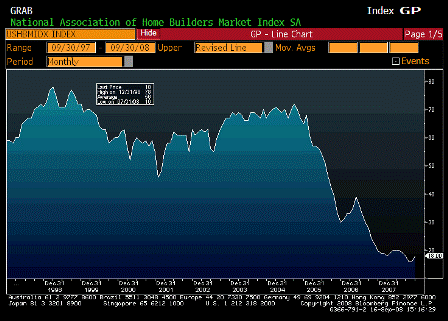
| Survey | 17 |
| Actual | 18 |
| Prior | 16 |
| Revised | n/a |
A touch better than expected, perking up a bit, but still very low historically and could spring back quickly with the agencies back in action.
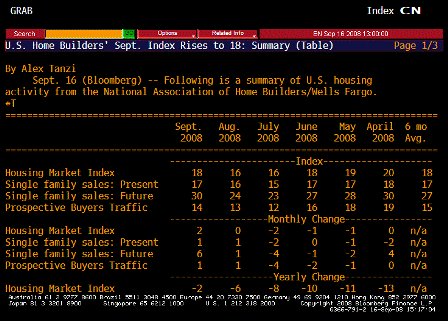
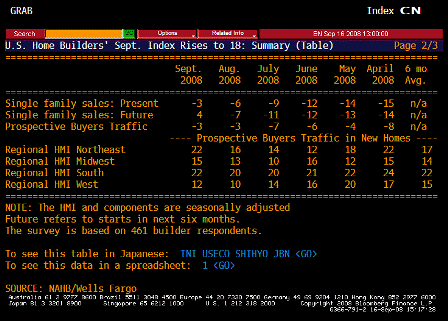
Future sales looking pretty good.
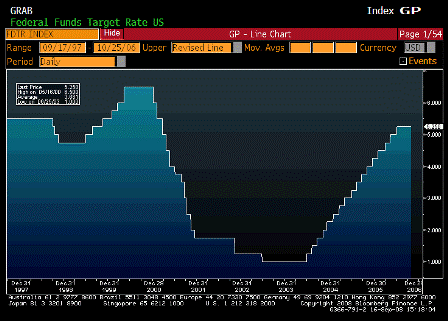
| Survey | 2.00% |
| Actual | 2.00% |
| Prior | 2.00% |
| Revised | n/a |
Wonder if Fisher cut a deal not to dissent for the Hawkish inflation language
Karim writes:
Headline CPI -0.137% m/m and core CPI up .194% m/m
Fed view likely reinforced that decline in commodity prices plus growing economic slack, especially in labor market, will dampen inflation into 2009.
[top]
Blip up due to the current turmoil.
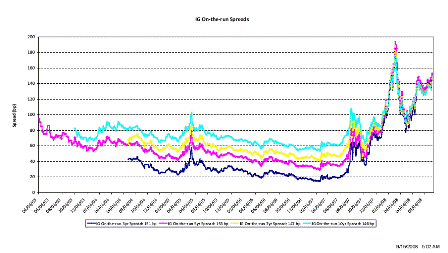
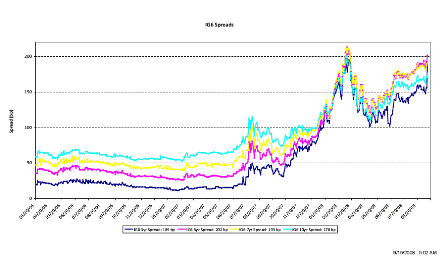
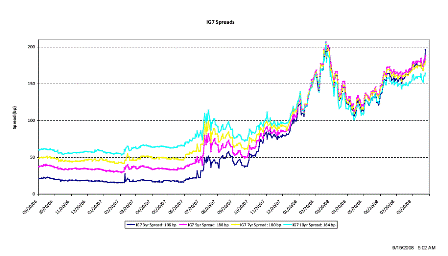
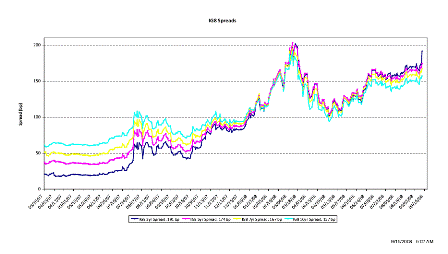
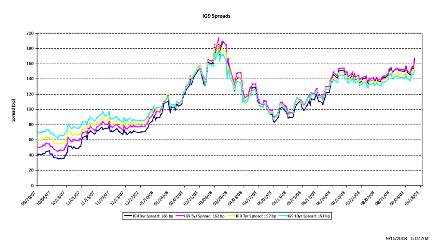
[top]
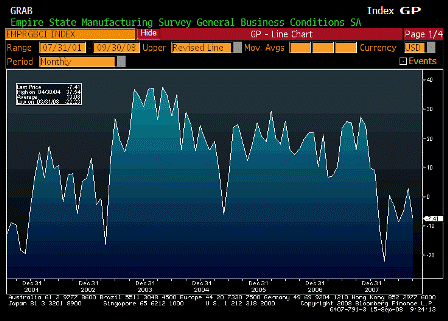
| Survey | 1.0 |
| Actual | -7.4 |
| Prior | 2.8 |
| Revised | n/a |
Down and worse than expected but still off the lows.
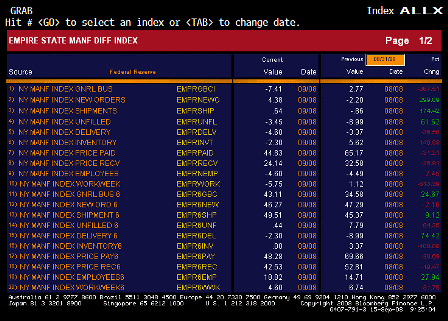
Employees and new orders up, while prices paid and received numbers moderated.
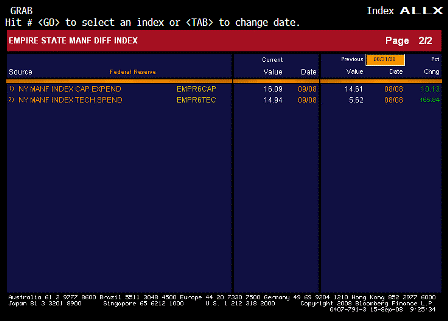
Capex and Tech spending up.

| Survey | -0.3% |
| Actual | -1.1% |
| Prior | 0.2% |
| Revised | 0.1% |
A lot worse than expected and prior month revised down.
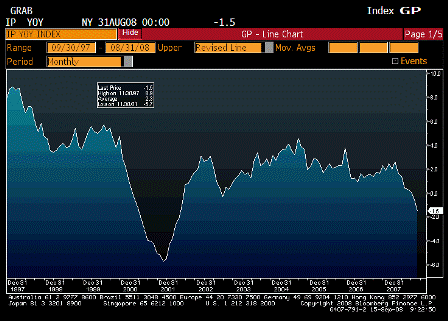
| Survey | n/a |
| Actual | -1.5% |
| Prior | -0.4% |
| Revised | n/a |
Not looking good. Ex autos still down .6 month over month.
[top]
I’ve been recommending the following for the Fed for quite a while (see Proposals for the Fed):
Failure to implement the above shows a failure to understand fundamental monetary operations.
These policy changes would alleviate critical liquidity issues, and not, per se, alter net bank reserve demand (not that the size of the bank reserve ‘matters’).
Part of the current crisis is due to the failure to implement the above changes that would have:
The Fed is slowly moving in that direction, but, unfortunately, not proactively to ‘fix’ a flawed institutional structure, but reactively as things fall apart in no small part due to lack of action:
Federal Reserve lowers standards for collateral from primary dealers
The collateral eligible to be pledged at the Primary Dealer Credit Facility (PDCF) has been broadened to closely match the types of collateral that can be pledged in the tri-party repo systems of the two major clearing banks. Previously, PDCF collateral had been limited to investment-grade debt securities.
The collateral for the Term Securities Lending Facility (TSLF) also has been expanded; eligible collateral for Schedule 2 auctions will now include all investment-grade debt securities. Previously, only Treasury securities, agency securities, and AAA-rated mortgage-backed and asset-backed securities could be pledged.
These changes represent a significant broadening in the collateral accepted under both programs and should enhance the effectiveness of these facilities in supporting the liquidity of primary dealers and financial markets more generally.
Also, Schedule 2 TSLF auctions will be conducted each week; previously, Schedule 2 auctions had been conducted every two weeks. In addition, the amounts offered under Schedule 2 auctions will be increased to a total of $150 billion, from a total of $125 billion. Amounts offered in Schedule 1 auctions will remain at a total of $50 billion. Thus, the total amount offered in the TSLF program will rise to $200 billion from $175 billion.
The Board also adopted an interim final rule that provides a temporary exception to the limitations in section 23A of the Federal Reserve Act. It allows all insured depository institutions to provide liquidity to their affiliates for assets typically funded in the tri-party repo market. This exception expires on January 30, 2009, unless extended by the Board, and is subject to various conditions to promote safety and soundness.
[top]
Here’s how I see the problem:
Therefore, while justified or not, this means the government can, on its own, decide to provide ‘taxpayer money’ AND eliminate all shareholder value.
This creates a serious risk for any shareholder for ANY business.
For an extreme example, the Treasury could decide unilaterally, that ANY corporation (including, for the strongest example, GE) needs a Treasury guarantee to be sure it can fund itself and won’t fail.
And any such action could carry with it eliminating any/all shareholder value.
This is the risk to Lehman shareholders.
Lehman may be perfectly able to function at some level without the need of new capital to survive.
But markets must now discount that possibility that the Treasury or Fed could decide Lehman’s counterparty risk poses sufficient systemic risk to justify intervention with ‘taxpayer money’ at risk, which would carry with it the elimination of all shareholder value.
The means the risk to shareholders from government intervention is much higher than the risk of bankruptcy or any other form of liquidation.
There was no economic reason for the Treasury to take 79.9% of the housing agencies capital. ‘Tax payer money’ was already as senior as the Treasury wanted it, and any funds added by Treasury also carried any type of interest and various other payments the Treasury desired.
All that wiping out most of the residual value for shareholders did was add a new element of catastrophic risk for all shareholders.
So when a stock like Lehman goes down, which increases the perception of risk of government intervention, the risk of shareholder value going to zero due to government intervention increases as well.
Not my first choice of institutional structure.
[top]
The last statement is most troubling.
Venezuela expels US ambassador, threatens to halt oil trade
CARACAS: Venezuelan President Hugo Chavez expelled the US envoy to Caracas late Thursday and threatened to halt crude exports to the United States on a day he highlighted the recent arrival of two Russian Tu-160 strategic bombers.
Chavez on Thursday ordered US ambassador Patrick Duddy to leave the country within 72 hours, in a move he described as an act of solidarity with Venezuela’s ally Bolivia, which also expelled its US envoy.
“Starting at this moment the Yankee ambassador in Caracas has 72 hours to leave Venezuela,” Chavez said at a public event in the port city of Puerto Cabello, 120 kilometres west of Caracas.
He said it was “in solidarity” with the leftist government of President Evo Morales in Bolivia, which on Wednesday ordered the US ambassador to La Paz to leave. Washington late Thursday expelled Bolivia’s ambassador to the United States.
Chavez then threatened to halt the supply of oil to the United States, its main client, if Washington attacks his government.
“If there is any aggression towards Venezuela” from Washington, “there would be no oil for the people of the United States,” said Chavez, who used coarse expletives to disparage the US government.
Chavez also announced Thursday that his government had uncovered a coup plot hatched by active and retired military officers, which he said had tacit US approval.
A military prosecutor said two officers — retired general Wilfredo Barroso and retired major Elimides Labarca Soto – will be tried for incitement to rebellion, a charge punishable by five to 10 years in prison.
At least eight other officers were detained in connection with the plot and were being interrogated, the prosecutor said.
Venezuelan public television aired a recorded conversation allegedly between three high-ranking retired military officers discussing plans to storm the presidential palace in Caracas, target Chavez, and blow up the presidential airplane.
“We have already detained several people,” Chavez said.
“Look, pitiyanquis, don’t even think of launching a coup or some madness such as this. I warn you, I am not the Hugo Chavez of 2002,” he said, referring to a failed coup attempt against him in April of that year, when he was briefly ousted for two days before mass protests saw him freed and return to power.
Chavez, a former paratroop officer, headed a failed coup attempt himself in 1992. He was elected president in 1999.
“I have no doubt at all that the United States is behind plans to bomb this palace,” Chavez said, warning that “difficult times” lied ahead for Venezuela.
The anti-US leader frequently alleges assassination and coup plots against him, usually pointing the finger at the United States.
Chavez said those behind the latest plot were part of the country’s “desperate political opposition” and “the American empire” led by US President George W. Bush.
Earlier in the day Chavez said the presence of two Russian Tu-160 strategic bombers in Venezuela is a “warning” to the US “empire,” as he announced another coup plot against him had been foiled and suspects arrested.
“It’s a warning. Russia is with us… we are strategic allies,” said Chavez. “It is a message to the empire. Venezuela is no longer poor and alone.”
Chavez had announced Wednesday that two Russian bombers were in Venezuela for “training flights” and that he would be piloting one of the aircraft himself.
“I hope that stings, ‘pitiyanquis’,” he said, using a derogatory term for Venezuelan opponents who have perceived US sympathies.
“What’s more, I’m going to take the controls of one of these monsters,” boasted the president, a former paratrooper and left-wing politician who has avowed antagonism towards the United States.
The United States said it would monitor the deployment of the two Russian bombers, which it described as “Cold War era assets,” to Venezuela.
The moves came amid soaring tensions between Russia and the United States, including over the presence of US naval vessels sent close to Russian shores to deliver aid to Georgia.
Russia said Monday it was dispatching a nuclear cruiser and other warships and planes to the Caribbean for the joint exercises with Venezuela – the first such manoeuvres in the US vicinity since the Cold War.
[top]